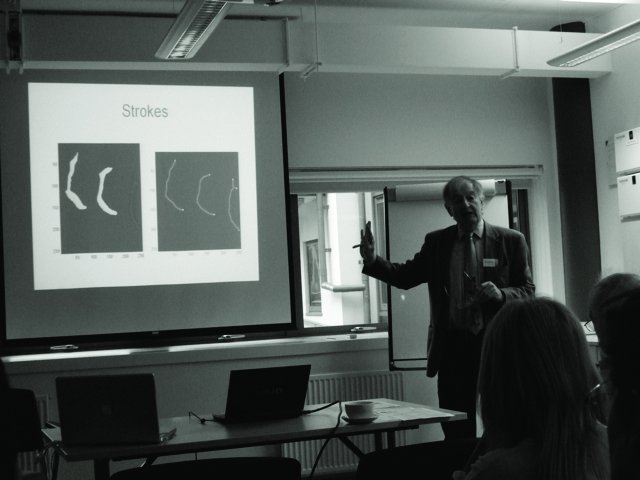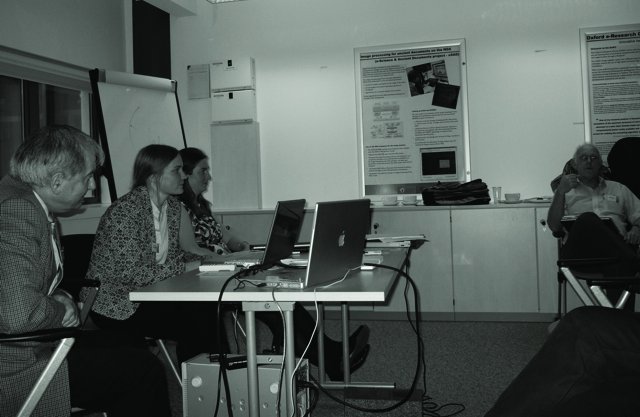|
First eSAD workshop held at the OeRC, University of Oxford on the 13th May 2009.
 
- Image, Text, Interpretation: problems and solutions: Alan's presentation
- Image Capture and Analysis for Inscribed Documents: Ségolène's presentation
- From Strokelets to Character Interpretations: Mike's presentation
- Aiding the Expert: Computers, Reading, and Ancient Texts: Melissa's presentation
- Building an Interpretation Support System: Henriette's presentation
- A Virtual Research Environment for the Study of Documents and Manuscripts:
- John's Demo Intro
|
|
Written by Segolene Tarte
|
|
Thursday, 21 May 2009 16:31 |
|
Please note that the workshop talks are available for download here. 1- Morning session About letter shapes - Is there any way to deal with statistical letter shapes? Melissa’s work did build statistical models of letter shapes for the Vindolanda ink tablets, based on positional probabilities within a character box. Another statistical modeling method would be by Principal Component Analysis, provided that enough samples are available. One question is then: “How much do letter shapes differ between ink tablets and incised tablets?”, and also “How could one ’compensate’ for the shapes not represented in the statistical model?” ’Compensating’ isn't quite the right term; what we want is in fact to inform and feed the database (and the model) with the newly found instances of letter shapes as well as consult it. For example in the case of the Frisian tablet (shown during the presentations), dated as a 1st Century AD tablet, a quite unique palaeography was found; ‘A’ as shaped in the document, would not have been identified as ‘A’s according to our current knowledge of shapes of ‘A’s in 1st Century AD Old Roman Cursive. |
|
Last Updated on Wednesday, 05 August 2009 10:19 |
|
Read more...
|
|
|
Written by Segolene Tarte
|
|
Wednesday, 06 May 2009 22:01 |
Detailed workshop programme:
10:00 - 10:30 Welcome Coffee
10:30 - 11:15 "Image, Text, Interpretation: problems and solutions" by Prof. Alan Bowman 11:15 - 11:45 "Image Capture and Analysis for Inscribed Documents" by Dr. Ségolène Tarte 11:45 - 12:15 "Letter Shapes and Ambiguity" by Prof. Sir Michael Brady 12:15 - 12:45 Quo vadis discussion, chaired by Prof. Alan Bowman
12:45 - 14:00 Sandwich lunch
14:00 - 14:30 "Aiding the Expert: Computers, Reading, and Ancient Texts" by Dr. Melissa Terras 14:30 - 15:00 "Building an Interpretation Support System" by Henriette Roued Olsen 15:00 - 15:30 Quo vadis discussion, chaired by Prof. Alan Bowman
15:30 - 16:00 Tea break
16:00 - 16:30 "Building a Virtual Research Environment for the Humanities" demo; followed by a sneak-peak demo of the integration of eSAD into BVREH (part of the ENGAGE initiative)
--------------------------------------------- Date: Wed. 13th May 2009, Time: 10:00-16:30 --------------------------------------------- |
|
Last Updated on Wednesday, 05 August 2009 10:20 |
|
Written by Segolene Tarte
|
|
Thursday, 02 April 2009 16:58 |
|
Investigators: Professor Alan Bowman, Professor Sir Michael Brady, Dr. Melissa Terras
Postdoctoral Research Assistant: Dr. Ségolène Tarte
Doctoral Student: Henriette Roued Olsen
This four-year interdisciplinary project, funded under the AHRC-EPSRC-JISC Arts and Humanities e-Science Initiative until September 2011, is based at the Centre for the Study of Ancient Documents and the Oxford e-Research Centre, with the collaboration of University College London. It aims to use computing technologies to aid experts in the complex tasks of reading damaged documents. A central part of the work involves creating tools to aid the reading of damaged texts such as the inscribed stilus tablets from the Roman fort of Vindolanda and elsewhere. We will also develop an Interpretation Support System (ISS), which will be used in the routine tasks of decipherment and will track the stages and the processes of decipherment and interpretation. A combination of image-processing tools and an ontology-based support system will be developed to facilitate ‘expert reading’ and track the development of hypotheses |
|
Last Updated on Friday, 25 September 2009 16:41 |
|
Read more...
|
|
|
|
|
|
|